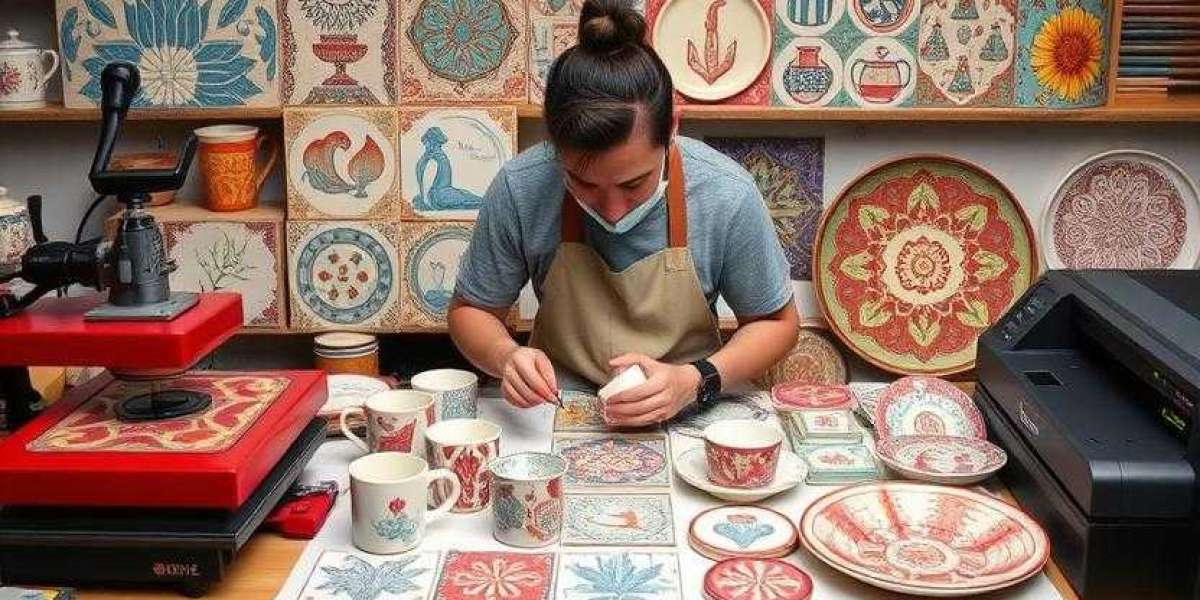Ceramic printing has become a popular and exciting way to bring creative ideas to life on a variety of ceramic surfaces. This process merges artistic vision with advanced printing technology, enabling designers, artists, and businesses to produce detailed, long-lasting, and vibrant images on items like mugs, tiles, plates, and decorative pieces. In this article, we’ll explore the art and science behind ceramic printing and how it transforms ordinary ceramic items into beautiful, customized creations.
Understanding the Ceramic Printing Process
At its core, ceramic printing involves transferring a digital design onto a ceramic surface using specialized printing techniques. There are several common methods used in ceramic printing, including sublimation, screen printing, and digital ceramic printing. Each method has its own advantages and is suited for different types of projects and surfaces.
Sublimation Printing
Sublimation is one of the most widely used techniques in ceramic printing. In this process, a design is first printed onto a special transfer paper using sublimation inks. When heat and pressure are applied, the ink turns into gas and bonds with the ceramic surface. This method creates vibrant, high-resolution images that are resistant to fading, scratching, and washing.
Screen Printing
Screen printing is an older but still popular technique, especially for mass production. It involves creating a stencil (or screen) for each color in the design, then applying ceramic ink through the screen onto the ceramic surface. Once the design is printed, the item is fired in a kiln to fuse the ink with the ceramic. This method is ideal for producing large quantities of items with simple, bold designs.
Digital Ceramic Printing
Digital ceramic printing is a more modern approach that uses specialized printers to apply ceramic inks directly onto the ceramic surface. After printing, the items are fired at high temperatures to permanently fuse the design. This method allows for precise, detailed, and colorful prints, making it a favorite for customized or limited-edition pieces.
Artistic Applications of Ceramic Printing
Ceramic printing is not just a technical process — it’s an art form that allows creators to express their vision on a durable medium. Here are some of the ways ceramic printing is used to create stunning artistic pieces.
1. Custom Home Decor
From decorative tiles and wall art to personalized plates and vases, ceramic printing opens up endless possibilities for home decor. Artists can design intricate patterns, photo collages, or even abstract art that transforms everyday ceramic items into eye-catching decor pieces.
2. Personalized Gifts
Ceramic printing makes it possible to design highly personal and meaningful gifts. Whether it’s a coffee mug with a loved one’s photo, a commemorative plate for a special event, or a set of coasters with a custom design, ceramic-printed gifts are always unique and cherished.
3. Limited-Edition Collectibles
Many artists and designers use ceramic printing to produce limited-edition collectible items. These pieces often feature exclusive artwork or designs that are printed onto ceramic sculptures, figurines, or decorative tiles, creating highly sought-after collectibles for art lovers.
4. Restaurant and Hospitality Use
Restaurants, cafes, and hotels often use ceramic printing to customize their tableware and decor. Plates, cups, and tiles can be printed with the establishment’s logo, theme, or signature designs, helping to reinforce brand identity and create a memorable customer experience.
Scientific Precision: Ensuring Quality in Ceramic Printing
While ceramic printing offers artistic freedom, it also requires scientific precision to ensure that the final products meet high standards of quality. Factors such as temperature, ink composition, firing time, and surface preparation all play critical roles in achieving the best results.
Temperature Control
One of the most important aspects of ceramic printing is controlling the temperature during the firing process. If the temperature is too low, the inks may not fully fuse with the ceramic surface, resulting in dull or faded prints. If it’s too high, the design may become distorted or the ceramic piece may crack.
Ink Composition
Ceramic inks are specially formulated to withstand the high temperatures used in the firing process. These inks contain a mix of pigments, solvents, and other materials that ensure the colors remain vibrant and the design adheres properly to the ceramic surface.
Surface Preparation
Before printing, the ceramic surface must be properly cleaned and prepared to ensure that the design adheres evenly. Any dust, oils, or imperfections on the surface can affect the quality of the final print, so careful preparation is essential.
The Future of Ceramic Printing
As technology continues to evolve, ceramic printing is becoming even more advanced and accessible. Innovations such as 3D ceramic printing are pushing the boundaries of what’s possible, allowing creators to print not just designs, but entire three-dimensional ceramic structures. Additionally, advancements in eco-friendly inks and sustainable production methods are making ceramic printing a greener option for artists and businesses alike.
Conclusion
Ceramic printing is a fascinating blend of art and science that transforms ideas into beautiful, durable creations. From personalized gifts and home decor to collectible art pieces and branded tableware, ceramic printing offers endless possibilities for customization and creativity. By mastering both the artistic and technical aspects of this process, creators can produce stunning works that captivate and inspire.



